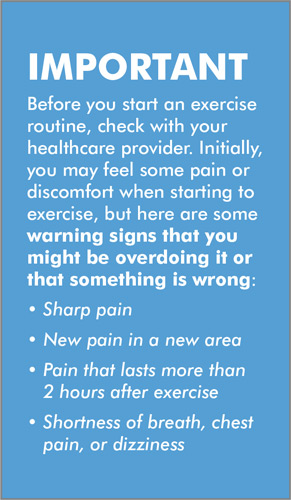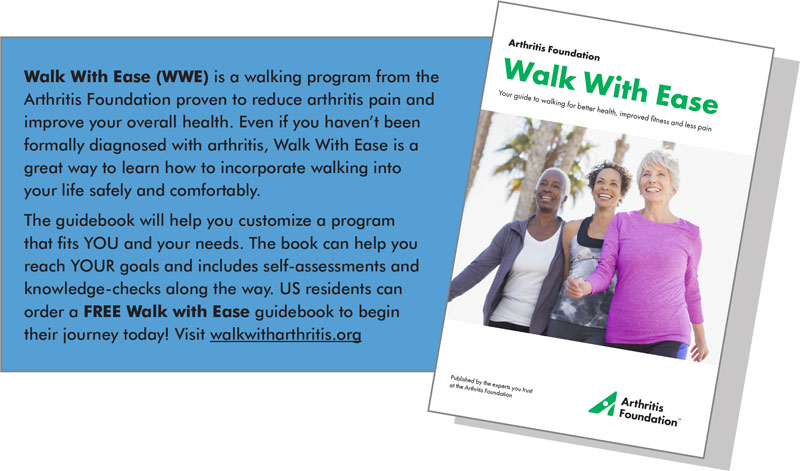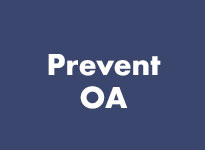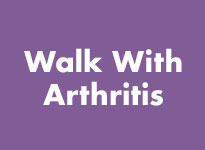Stay Active
Take One Step Forward: Stay Active with Osteoarthritis
Get inspired by Vicky’s story
A Doctor’s tips for staying active
Stiffness, swelling, and pain in your joints from osteoarthritis (OA) should not keep you from your favorite activities. There is a common myth that being active could make your joint pain symptoms worse, but the opposite is true!
Doing simple exercises to build your strength and keep your body moving can reduce your pain and stiffness.
Osteoarthritis (OA) is the most common type of arthritis. For most people, OA can get worse over time if you don’t address the symptoms now.

Find Your Fit
Not every type of exercise is for everyone. Experiment to find the kind that works for you. The key is finding something that you enjoy and can stick with over time. Remember that as your symptoms change over time, you may need to adjust your activity and try a different exercise routine. Use our online guide to create an exercise plan for yourself based on your current activity level.
Arthritis-Friendly Exercises
Low-impact activities can keep you moving and help build strength. Whatever you choose, start with just 10-15-minutes or less and build up your endurance over time. Try to do your exercise at least three times a week to get you on the road to less joint pain. Eventually, aim for exercising at least five days a week.
- Walking – Take a short walk around the neighborhood. Did you know that people who walk with a friend – human or furry – actually spend more time walking than those who go it alone?
- Water Exercise – Water aerobics or swimming can help build strength while relieving joint pain.
- Yoga – Build strength, improve flexibility, increase blood flow and calm your mind with a gentle yoga session.
- Stretching and strengthening exercises – Regular stretching and strengthening will help improve your range of motion and strengthen your muscles to make your everyday activities easier to get done.
Do One Thing to Move More
- Park your car farther away from the store or library.
- Complete some stretches or strengthening moves while watching your favorite television show.
- Combine your walks with another activity, like listening to a podcast or an audiobook.
- Use an activity tracker, pedometer, or mobile app to log your steps and set new personal goals.
- Reward yourself each time you reach a goal.
There is no cure for arthritis. However, joint pain and OA symptoms can be managed through various treatments, physical activity, lifestyle changes, and education. Visit oaaction.unc.edu/jointpain to learn about treatment and lifestyle changes that get you on the path to less joint pain.

Walk With Ease (WWE) is a walking program from the Arthritis Foundation proven to reduce arthritis pain and improve your overall health. Even if you haven’t been formally diagnosed with arthritis, Walk With Ease is a great way to learn how to incorporate walking into your life safely and comfortably.
The guidebook will help you customize a program that fits YOU and your needs. The book can help you reach YOUR goals and includes self-assessments and knowledge-checks along the way. US residents can order a FREE Walk with Ease guidebook to begin their journey today!
ORDER NOW
Take Steps to Learn About OA
Active Living Resources
It is recommended that adults with OA get 2.5 hours of moderate aerobic (walking, running, etc.) and 2 days of muscle-strengthening exercise per week to reduce pain and improve function. Always consult with your healthcare provider before beginning any physical activity routine, especially if you have special issues or multiple chronic conditions.
Physical activity programs can help you learn to manage your symptoms while becoming more active. Physical activity can decrease pain, improve physical function by about 40%, and may reduce healthcare costs. The following are community-based programs that are proven to improve arthritis symptoms and help you increase your physical activity safely and effectively.
Active Living Everyday (ALED) This is a classroom-based program for people who want to become and stay more physically active. This workshop meets for 1 hour a week for 12 or up to 20 weeks. Benefits of this program include: increased physical activity and aerobic fitness, decreased stiffness, and improved blood pressure, blood lipid levels, and body fat.
Fit and Strong! This group based fitness program was created for sedentary older adults who are experiencing lower-extremity joint pain and stiffness, but is appropriate for all. This is a group-based program that meets for 90 minutes, 3 times a week. One hour of the class is focused on exercises, such as flexibility, strength training, and aerobic walking. The remainder of the time is spent on health education for arthritis management. This program improves lower extremity stiffness, pain and strength, aerobic capacity, and symptom management.
Walk With Ease (WWE) offers practical advice on how to walk safely and comfortably, while also providing lots of strategies to help keep you walking and overcoming challenges that can interfere with an exercise program. WWE is a six-week program that can be delivered in two formats: instructor-led group or self-directed individual; both formats utilize a step-by-step workbook that educates you on safe walking, exercise safety, and symptom management.
Group-led: The group-led classes are taught by trained instructors and are usually held in community-based settings (e.g. community centers, senior centers), healthcare settings, and worksites.
Self-Directed: The self-directed version of WWE can be completed at your own convenience and pace using the WWE workbook. For a limited time, you can sign up for the self-directed Walk With Ease for FREE on our Walk With Arthritis page.
Camine Con Gusto: The Hispanic version of WWE, Camine Con Gusto, is also available. A community trial testing Camine Con Gusto showed improvement in self-reported outcomes in Hispanics comparable to those found in non-Hispanic white and black individuals with self-reported arthritis. Camine Con Gusto is offered only in the self-directed format and can be purchased here.
Enhance Fitness (EF) This program is designed for older adults and people aging with disability. This is a group-based program typically held in senior centers, residential sites, YMCAs, community centers, churches and more. This is a 16-week class, but is ongoing at many sites. Classes are usually held for 1 hour, 3 days a week. Benefits include increased strength, improved flexibility and balance, boosted activity levels, elevated mood, and increased social activation.
Walk With a Doc (WWAD) is a unique, physician-led walking program focused on encouraging physical activity among the community. Each walk is hosted by a physician speaking about a health topic of interest. Click here to find a WWAD chapter near you.
An important part of being able to stay active throughout life is preventing injury, and according to the CDC, falls are a leading cause of injury for the aging population. The good news: some of the programs mentioned above are also considered to be effective falls prevention programs by the National Council on Aging. Check out this flyer to learn more about the programs that can help you stay active, help manage or prevent osteoarthritis, and prevent falls!
Learn more about all arthritis-approved programs on our AAEBI webpage.
Other Resources to Help You Stay Active
- Arthritis Foundation: Exercises for Arthritis – How-to’s on exercising with arthritis, arthritis-friendly workouts and videos, recommended activities and more
- National Recreation and Parks Association: Arthritis Interventions – NRPA is proud to partner with the National Association of Chronic Disease Directors (NACDD) and the Centers for Disease Control and Prevention (CDC) to implement the Walk with Ease (WWE) and the Active Living Every Day (ALED) programs in communities around the country. Check out their Ingredients for Success!
- Obesity Action Coalition: Walk into Weight Loss and Health – Article by Mira Rasmussen, BS, ACSM-HFS in Your Weight Matters Magazine, Spring 2015
- American College of Rheumatology: Exercise and Arthritis – Fast facts about exercise and arthritis plus recommendations for where, when, and how to exercise with arthritis
- Living Well Resources from the Center for Enhancing Activity & Participation among Persons with Arthritis (ENACT):
- Objective physical activity measurement in the Osteoarthritis Initiative: Are guidelines being met? – Research article on how many people are following public health physical activity guidelines and why intensified efforts to increase physical activity among people with knee OA are warranted.
- Physical Activity Guidelines for Americans – A resource to learn how physical activity helps us all and activities that can get you moving.
Explore More
The information provided on this website is for educational purposes only. Always consult your doctor before starting any new treatments or if you have any questions about your current treatment.









